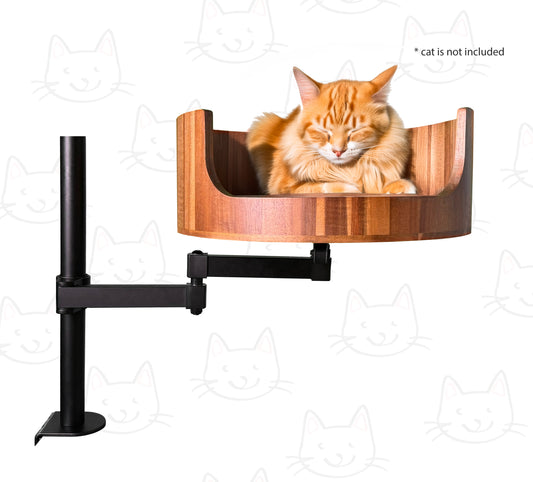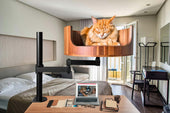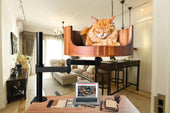
Cats Age Versus Human Years: Understanding the Difference
Share
Cat owners often find themselves curious about how old their feline companions are in human years. While the popular belief is that one cat year is equivalent to seven human years, the reality is much more complex. Understanding the true age of a cat in relation to human years involves factors such as breed, size, and overall health. In this article, we will delve into the science behind cats aging versus human aging, debunking common myths and providing a more accurate understanding.
Desk Cat Nest seeks to bridge the gap in knowledge between cat owners and the aging process of their beloved pets. From discussing the lifespan of different cat breeds to exploring the impact of genetics on aging, we aim to provide valuable insight into this often misunderstood topic. By the end of this article, readers will have a clearer understanding of how to properly assess and care for their cats as they grow older, debunking misconceptions and embracing the unique journey of feline aging.
1. Cats age at a different rate compared to humans, making it important to understand their life stages in order to provide appropriate care.
2. The common belief that one cat year is equivalent to seven human years is inaccurate and oversimplifies the aging process of felines.
3. The first two years of a cat's life are crucial for development, with rapid physical and behavioral changes occurring during this time.
4. By understanding how cats age in relation to humans, pet owners can better address their evolving needs as they transition from kitten to senior cat.
5. Consulting with a veterinarian can provide insight into your cat's individual age-related health concerns and help tailor their care accordingly.
The Science Behind Cat Age vs. Human Years
While it is a common belief that one cat year is equivalent to seven human years, the reality is much more complex. The aging process in cats differs from that of humans due to various factors such as breed, size, and genetics. Researchers have developed more accurate formulas to determine a cat's age in human years, taking into account their life stages and maturity levels. Understanding the science behind cat age versus human years can help caregivers provide appropriate care and monitor their feline friends' health more effectively.
Calculating Cat Age in Human Years
To calculate a cat's age in human years, factors such as their breed and size must be considered. For example, smaller breeds tend to live longer than larger breeds, so their aging process may be slower. There are various online tools and charts available to help pet owners determine their cat's age in human years accurately. By knowing the equivalent human age of their cat, caregivers can make informed decisions about their pet's diet, exercise routine, and veterinary care needs.
Common Myths and Misconceptions
One of the most widespread myths about cat age versus human years is the seven-year rule. While this may provide a rough estimate, it does not accurately reflect a cat's aging process. In reality, cats mature rapidly in their early years and then age more slowly as they reach adulthood. It is essential for pet owners to dispel these myths and educate themselves on the true factors that influence a cat's aging process. By understanding the common misconceptions surrounding cat age, caregivers can provide better care for their feline companions.
Desk Cat Nest FAQ
How can I calculate my cat's age in human years?
There is a common misconception that you can simply multiply your cat's age by 7 to get their age in human years. However, the calculation is a bit more complex. The first two years of a cat's life roughly equate to 25 human years, and after that, each additional year is equivalent to about 4 human years.
Why is it important to know my cat's age in human years?
Understanding your cat's age in human years can help you provide appropriate care for them as they age. Just like humans, cats require different levels of care and attention at different stages of their life. By knowing their age in human years, you can better anticipate their needs and ensure they live a happy and healthy life.
Does the Desk Cat Nest cater to cats of all ages?
Yes, the Desk Cat Nest is suitable for cats of all ages. Whether your cat is a playful kitten or a senior cat in need of extra comfort, the Desk Cat Nest provides a cozy and secure space for them to relax and rest.
Will the Desk Cat Nest help older cats with joint pain or arthritis?
While the Desk Cat Nest may not directly treat arthritis or joint pain in cats, the comfortable and supportive design of the nest can help alleviate some discomfort. The soft cushioning and warmth of the nest can provide relief for older cats with mobility issues.
In conclusion, the Desk Cat Bed is a valuable choice for cat owners looking to help their feline companions navigate the aging process in human years. This comfortable and cozy bed provides a safe and supportive place for cats to rest and relax, promoting better overall health and well-being. By offering a designated space for cats to rest, sleep, and recover, the Desk Cat Bed can help to alleviate the physical and mental stress associated with aging, ultimately extending the lifespan and quality of life for our beloved pets. Make the smart choice for your cat's health and happiness - invest in a Desk Cat Bed today.



















































